|
SpaceTides e-zine
#52 – March 2007
Internet
Newsletter of ASSA Bloemfontein Centre, South
Africa, to the public
www.assabfn.co.za/spacetides

|
Subscribe to the free SpaceTides e-zine by
sending an e-mail to spacetides@assabfn.co.za
with the word "Subscribe" in the subject line if you are not
already subscribed. |
In this issue of SpaceTides |
INDEX
Double click on
this email in your inbox to open it in a full window
1. Spaceflight
news from around the world
- Stunning views of
Jupiter's moon Io by the New Horizons probe
- Rosetta probe flies by Mars and gets a
special view of the Red Planet
2. Astronomy
news from around the world
-
Atmosphere around an exoplanet? A surprise from Spitzer
- Integral satellite may have found
fastest neutron star yet
3. Interesting
space facts: The Threat of
Near-Earth Objects
4. The
Solar System: The Ring Planet Saturn
5. Sky
Observation log: March 2007 night skies
6. Global
Warning: World Meteorological Day 2007
7.
Astronomy
events in the City of Bloemfontein
- Boyden Observatory open evening on 24 March 2007
8. Astronomy
in Southern Africa:
- Your participation in the international Globe-at-Night project awaits...
- Video astrophotography and satellite tracking
- Get ready for Scope-X in April!
9. Promotion
(non-profit): Toastmasters: an excellent way to improve your speaking skills
___________________________________________________________________________________________
Dear
SpaceTides Subscribers
It seems most of South Africa had cloudy weather around the time of the total
lunar eclipse of 3 to 4 March 2007. South African photos of the eclipse
can however, be found at http://assa.saao.ac.za/news/2007/lunareclipse.htm
The winner of the Sky Guide Africa South 2007 in last issue's lucky
draw was H. Lombard - congratulations!
You are invited to take part in the exciting Globe-at-Night project, and contribute to professional research about the state of light pollution on
Earth. It is simple and fun and the ideal family activity.
See section 8.
Regards,
Gerrit Penning
Editor
Total subscribers as at 1 March 2007: 733 (-31 due to list
cleaning, i.e. removal of dormant addresses) |
1. Spaceflight news from around the world |

|
Stunning views of Jupiter's moon Io by the New Horizons probe
From
a New Horizons Photo release, NASA/JPL. 28 February 2007. Read
full article.
This dramatic image of Jupiter's third largest moon "Io" was taken
by the Long Range Reconnaissance Imager (LORRI) onboard the New Horizons
space probe on 28 February. This came only about 5 hours after the
spacecraft's closest approach to Jupiter. The distance to Io was 2.5
million kilometers. One LORRI pixel shows 12 kilometers on Io.
This is the last of
a handful of LORRI images that New Horizons is sending "home"
during its busy close encounter with Jupiter - hundreds of images and other
data are being taken and stored onboard. The rest of the images will be
returned to Earth over the coming weeks and months as the spacecraft speeds
along to Pluto.
New Horizons is the first ever space probe to fly to Pluto and the other
Kuiperbelt objects.
Arrival at the dwarf planet is slated for 2015. NH homepage: http://pluto.jhuapl.edu/
Image at left
shows massive volcanic plume erupting into space (top). NASA-JPL. |
________________________________________________________________________________________

A view of
Mars from the Rosetta space probe. Credit: ESA
|
Rosetta
takes a special glimpse of Mars
Based on an ESA
news release, 25 February 2007. Read full
article.
This stunning view, showing portions of the European
Space Agency's Rosetta spacecraft with Mars in the background, was
taken by the Rosetta Lander Imaging System (CIVA) on board Rosetta’s Philae
lander just four minutes before the spacecraft reached closest approach to
the Red Planet in February.
Launched three years ago, the Rosetta probe flew just 1 000 km above the
Martian surface at a speed of about 36 300 km/h relative to the Red Planet.
This Mars flyby created a slingshot-boost for Rosetta, to put the spacecraft
on a path to reach Earth on November 13 for a similar maneuver.
Rosetta already made a fly-by of Earth in 2005, and will fly past Earth two
more times later this year and in 2009 (both for a speed-boost and to put it
on course for its final destination, comet 67P/Churyumov-Gerasimenko in early 2014.
Rosetta homepage at ESA: www.esa.int/SPECIALS/Rosetta/
More
info at Spaceflightnow.com: www.spaceflightnow.com/news/n0702/25rosettamars/ |
2. Astronomy news from around the world |
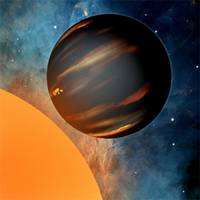
Artist
rendering of an exoplanet. Credit: David A. Aguilar (CfA)
|
An
Atmosphere around an Exoplanet?
Extracts from a
NASA news release dated 21 February 2007. Read
full Article.
NASA's Spitzer
Space Telescope has captured for the first time enough light from
planets outside our solar system, known as exoplanets, to identify molecules
in their atmospheres. It was done using spectrum analysis. This
surprise achievement is a significant step toward being able to detect
possible life on rocky exoplanets in the future and comes years before
astronomers had anticipated. So far, most exoplanets found are similar to the
gas giant Jupiter, but dubbed "hot Jupiters" as they orbit very
close to their parent stars.
The data indicate the two planets studies are drier and cloudier than
predicted. Theorists thought "hot Jupiters" would have lots of
water in their atmospheres, but surprisingly none was found around HD 209458b
and HD 189733b. According to astronomers, the water might be present but
buried under a thick blanket of high, waterless clouds.
A spectrum is created when an instrument called a spectrograph splits
light from an object into its different wavelengths, just as a prism turns
sunlight into a rainbow. The resulting pattern of light, the spectrum,
reveals "fingerprints" of chemicals making up the object. |
_______________________________________________________________________________________
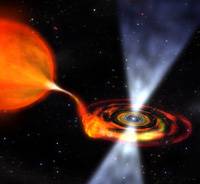
Artist
rendering. NASA/Dana Berry
|
Integral satellite may have found fastest neutron star yet
Extracted
from an ESA News release dated 16 February 2007. Read full
article.
Scientists
working with ESA's gamma-ray observatory called Integral, have
detected what appears to be the fastest spinning neutron star yet. This tiny
stellar corpse is spinning 1122 times every second. If confirmed, the
discovery gives astronomers the chance to glimpse the insides of the dead
star.
Just because a star dies, it doesn't mean its life is
over. A neutron star is the tiny heart of a collapsed star. Measuring about
10 kilometres across, yet containing something like the mass of the Sun, the
interior of a neutron star is the most exotic realm that astronomers can
imagine. According to their calculations a thumb-sized piece of neutron star
material weighs a hundred million tonnes. ESA
Integral homepage: www.esa.int/SPECIALS/Integral/index.html
The image at left shows a spinning neutron star sucking in gas from a
companion star (artist rendering). More about neutron stars and black holes on
Wikipedia.org. |
3. Interesting Space Facts |
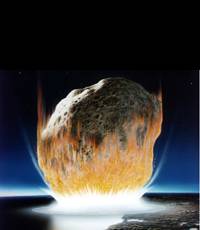
|
The
Threat of Near-Earth Objects
Near-Earth Objects (NEOs) are meteoroids, asteroids, and comets whose
orbits lie close to Earth's. They can also sometimes cross our planet's
orbit.
NEOs pose a potential threat to life on Earth. It has gained much
public attention in recent years, partly due to Hollywood movies, but also
through increased scientific understanding of NEOs and their potentially
destructive consequences.
The crash of Comet Shoemaker-Levy 9 into Jupiter in 1994 showed that
collisions are still happening even today in our solar system.
More than 3,400 Near-Earth Asteroids (NEA's) have been found to
date, which is only a fraction of their suspected total population.
"1036 Ganymed", with an approximate diameter of 41 kilometers, is
the largest NEA. It is currently estimated that there are about 1 100 NEAs
with diameters larger than 1 kilometer; they are large enough to produce
global catastrophe if they were to hit Earth...
More information: http://www.planetary.org/explore/topics/near_earth_objects/ |
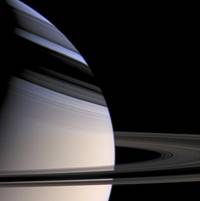
The Planet Saturn.
Credit: NASA/JPL/SSI
|
The
Ringed Planet Saturn
Saturn
is the 6th planet from the Sun and second largest. It has an impressive ring
system that clearly distinguishes it from the other planets in our solar
system.
The planet is mostly gaseous, consisting primarily of
hydrogen and helium. Its volume is 755 times greater than that of the Earth.
Saturn has very fast winds: combined with heat rising from within the
planet's interior, the winds cause the yellow and gold bands visible in the
atmosphere. It is the only planet that is less dense than water.
Saturn's interior is similar to Jupiter's: it also has a
rocky core at the center, a liquid metallic hydrogen layer above that,
followed by a layer of molecular hydrogen.
The ring of Saturn consists mostly of iced particles, rocks
and dust. Although it is over
250 000 km in diameter, it is only a few kilometers
thick! It is not one solid ring: various ringlets make up the total ring
structure.
Image left: "State of
beauty". Saturn's visual colours appear through filters on Cassini
cameras, from 1 million km distant. More info on
Saturn. |
|
This is the 7th part in a 12-part series about the Solar System.

|
Naked
eye Planets - March 2007
Mercury is
visible in the morning skies and is best viewed at month-end.
Venus shines bright in the evening skies just after sunset in the west
- a beautiful sight.
Earth is still spinning round and round and round...
Mars rises in the mornings at about 3h30.
Jupiter rises after midnight and is visible throughout the morning.
Saturn can be seen all night, located in Leo in the north-east in the
evenings.
The planets move through the sky on an imaginary line, called the ecliptic.
The ecliptic represents the plane (disc) on which the planets revolve around
the Sun. Can you think why the ecliptic makes an angle of about 23 degrees
with the equator?
Refer to the Sky Guide 2007 for detailed planetary rise and set times.
Other celestial
events - March 2007
- Full Moon on 4 March
2007. New Moon on 19 March 2007
- The Moon will occult the M4 globular star cluster on 11 March 2007 from
4h30, 0.7 degrees
from the bright red star Antares.
- 21 March is time for the autumn equinox again.
Take a binocular and scan through the milky way - especially in the
south-east (even from city skies!) You'll be surprised to see how many
stunning deep sky objects you can see. More about them next month in
SpaceTides... |
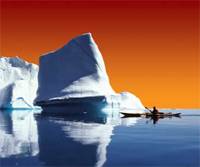
Credit: WMO, Christian Morel
|
World Meteorological Day 2007 - 23 March
Excerpt from the WMO's information
brochure: "The WMO Executive Council decided that the theme for
World Meteorological Day in 2007 would be “Polar meteorology: understanding
global impacts”. In recent decades, great advances have been made in our
understanding of the role of the polar regions in the global climate system.
Shrinking sea-ice, melting ice sheets, the discharge of glaciers and thawing
of permafrost are all dramatic changes that have been taking place in those
regions owing to an increase in global average temperature."
"It is evident that the increased average rate of sea-level rise
resulting from the melting of ice of land origin would be dangerous for
lowlands and some islands whatever their geographical location. Ocean
circulation changes may have an impact on the distribution of temperature,
salinity and organic substances in tropical areas. This would have a crucial
impact on fish stocks and therefore on national economies, livelihoods and
our eating habits". Source: more information on the WMO's
website: http://www.wmo.ch/wmd/ |
7. Astronomy events in Bloemfontein |
Boyden Sterrewag Ope-aand vir die publiek, Bloemfontein
Datum: Saterdag, 24 Maart 2007
Tyd: 18h45 vir 19h00
Koste: R30 per voertuig
Plek: Boyden Sterrewag op Harvard
koppie langs Maselspoort, Bloemfontein
Spreker: Dr. Peter Martinez van SAAO in
Kaapstad/Sutherland
Tema: "Wetenskap met SALT: Hoe die Suider-Afrikaanse Groot
Teleskoop sal help om sterrekunde se groot vrae te beantwoord".
Aangebied deur: Die Vriende van Boyden Sterrewag, in samewerking met
ASSA Bloemfonteintak
Bespreking is
noodsaaklik. Besprekings open egter eers 19 Maart 2007. Skakel reeds daardie Maandag
051-401 2561 om jou plek te verseker, aangesien plekke baie vinnig opgeneem
word.
Verversings
sal te koop wees.
Boyden Observatory Open Evening
for the public, Bloemfontein
Date: Saturday, 24 March 2007
Time: 18h45 for 19h00
Cost: R30 per vehicle
Venue: Boyden Observatory on Harvard Hill next to Maselspoort,
Bloemfontein
Speaker: Dr. Peter Martinez of the SAAO in Cape Town/Sutherland
Topic: "Science with SALT: How the Southern African Large
Telescope will help to answer astronomy's big questions".
Organised by: The Friends of Boyden with assistance from ASSA
Bloemfontein Centre
Reservation is essential. Bookings open on Monday 19 March 2007. Phone
051-401 2561 on that Monday, as seats go fast. Refreshments will be for sale. |
8. Astronomy in Southern Africa |
South Africans
invited to participate in the International Globe-at-Night Project
All you need to do is go outside for one evening during the period 8 to 21
March 2007 and compare YOUR view of the Orion star field with star
maps supplied by Globe at Night. Easy and simple. Visit Globe-at-Night's website and
download the family pack with full instructions. You can also send your
results to SpaceTides for
recognition of your name on the internet. This is your opportunity to help
fight light pollution: a growing concern that is busy destroying our precious
night skies for next generations. In the process you can also do something
fun and educational together with your children.

Satellite Tracking and Video
Astrophotography
Interested in satellite tracking and video astrophotography? See
fascinating pictures of satellites and other objects on national ASSA's Video Astrophotography page.
Scope-X in Johannesburg on 21
April 2007
The well-known annual telescope and astronomy expo called Scope-X,
organized by the Johannesburg Centre of ASSA, will take place on Saturday, 21
April 2007 in Johannesburg. Download PDF Information brochures in Afrikaans
or English by visiting the Johannesburg
Centre's website.
Main theme: Astrophotography. International guest speaker Richard
Berry from the USA will deliver the keynote talk. You can also
attend a special dedicated workshop on 20 April presented by Richard. |
9. Promotion section (non-profit) |
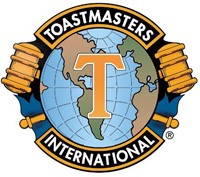
|
Scared
of Speaking in Public? Need more self-assurance to talk in front of an
audience?
Toastmasters International is a non-profit organisation that started
in 1924. Since then it has helped millions of men and women to become more
confident when speaking in front of an audience. Find the nearest club to
you.
Bloemfonteiners can visit the local club's website here or
phone Gerrit Penning for more information (051-522 2536 all hours). Die
"Toastmasters" is ook 'n uitstekend geleentheid om jou Engels te
verbeter. Dit het reeds talle lede gehelp om met meer selfvertroue in
Engels voor gehore te praat. |
|



